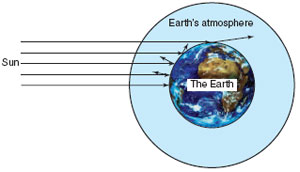The Sun’s energy
ContentThe energy that drives our weather systems comes from the sun in the form of solar radiation. The sun radiates waves of electro-magnetic energy and high-energy particles into space. This type of energy can pass through a vacuum and through gases. The Earth intercepts the radiation energy and, as these energy waves pass through the atmosphere, they are absorbed, scattered and refl ected by gases, air molecules, small particles and cloud masses (see Figure 2.2). About a quarter of the total radiation entering the atmosphere reaches the Earth’s surface directly. Another 18 per cent arrives indirectly after being scattered (diffused). The surface is warmed as the molecules of rock, soil, and water at the surface become excited by the incoming radiation; the energy in the electro-magnetic waves is converted to heat energy as the surface material absorbs the radiation. A reasonable estimate of energy can be calculated from the relationship between radiation and sunshine levels. The amounts received in the British Isles are shown in Figure 2.3 where the differences between winter and summer are illustrated.
Effect of latitude Over the Earth’s surface some areas become warmed more than others because of the differences in the quantity of radiation absorbed. Most energy is received around the Equator where the sun is directly overhead and the radiation hits the surface at a right angle. In higher latitudes such as the British Isles more of the radiation is lost as it travels further through the atmosphere. Furthermore, the energy waves strikes the ground at an acute angle, leading to a high proportion being refl ected before affecting the molecules at the surface (see Figure 2.4).
As a consequence of the above, more energy is received than lost over the span of a year in the region either side of the Equator between the Tropic of Capricorn and Tropic of Cancer. In contrast, to the north and south of these areas more energy radiates out into space, which would lead to all parts of this region becoming very cold. However, air and water (making up the Earth’s atmosphere and oceans) are able to redistribute the heat. Movement of heat and weather systems Heat energy moves from warmer areas (i.e. those at a higher temperature) into cooler areas (i.e. those at a lower temperature) and there are three types of energy movement involved. Radiation energy moves efficiently through air (or a vacuum), but not through water or solids. Heat is transferred from the Earth’s surface to the lower layers by conduction. As soil surfaces warm up in the spring, temperatures in the lower layers lag behind, but this is reversed in the autumn as the surface cools and heat is conducted upwards from the warmer lower layers. At about one metre down the soil temperature tends to be the same all the year round (about 10°C in lowland Britain). Heat generated at the Earth’s surface is also available for redistribution into the atmosphere. However, air is a poor conductor of heat (which explains its usefulness in materials used for insulation such as polystyrene foam, glass fi bre and wool). It means that, initially, only the air immediately in contact with the warmed surface gains energy. Although the warming of the air layers above would occur only very slowly by conduction, it is the process of convection that warms the atmosphere above. As fl uids are warmed they expand, take up more room and become lighter. Warmed air at the surface becomes less dense than that above, so air begins to circulate with the lighter air rising, and the cooler denser air falling to take its place; just as with a convector heater warming up a room. This circulation of air is referred to as wind. In contrast, the water in seas and lakes is warmed at the surface making it less dense which tends to keep it near the surface. The lower layers gain heat very slowly by conduction and generally depend on gaining heat from the surface by turbulence. Large-scale water currents are created by the effect of tides and the winds blowing over them. On a global scale, the differences in temperature at the Earth’s surface lead to our major weather systems. Convection currents occur across the world in response to the position of the hotter and colder areas and the influence of the Earth’s spin (the Coriolis Effect). These global air movements, known as the trade winds, set in motion the sea currents, follow the same path but are modifi ed as they are defl ected by the continental land masses (see Figure 2.5).
|








